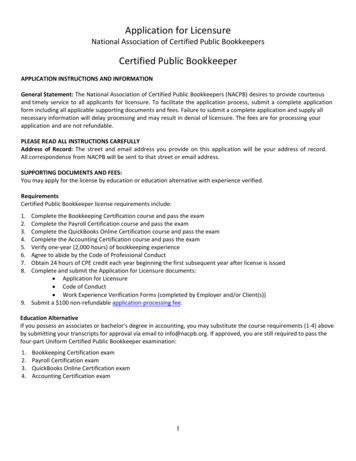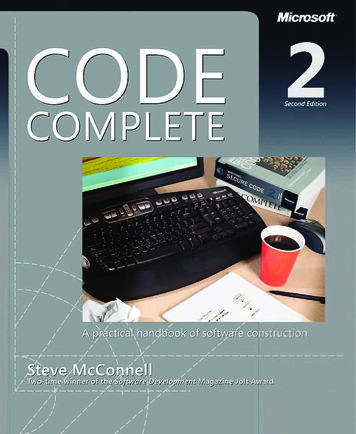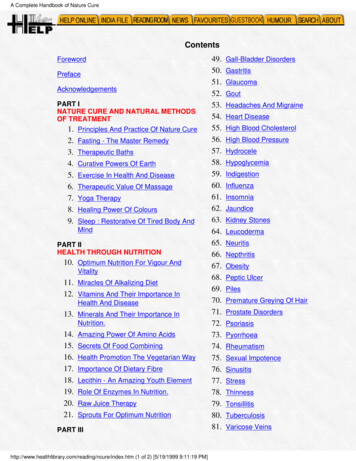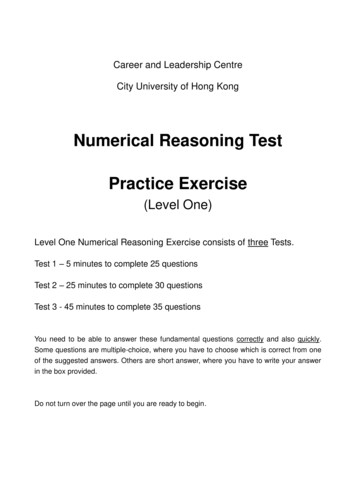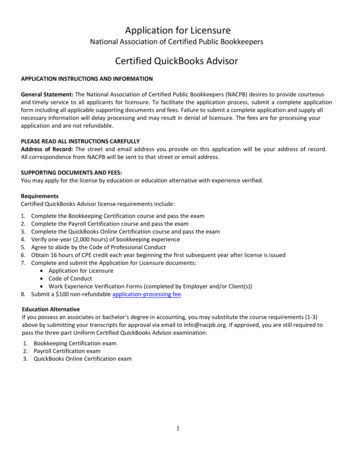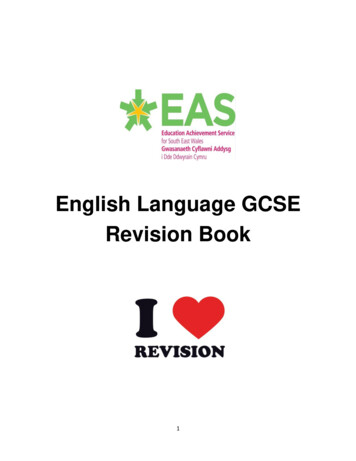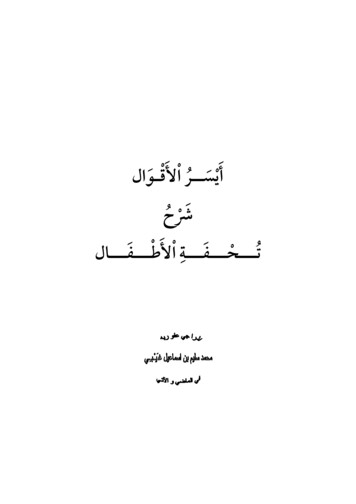
Transcription
First Published 2007By Madbūt Writers & TranslatorsWestern CapeSouth Africamuaadth allie@yahoo.comAny part of this book may be reproduced for teachingpurposes with condition that no alterations are made init.Books may be bought or ordered by contacting madbutat the above email2
CONTENTSContentsAcknowledgmentsSystem of transliteration345IntroductionBiography of JamzūrīJamzūrī’s sanadThe author’s link to Mustafā al-MīhīThe text of the TuhfahThe MuqaddimahThe rules of nūn sākinah and tanwīnThe rules of mīm and nūn mushaddadatainThe rules of mīm sākinahThe ruling of lām of al and lām of the verbMithlain, mutaqāribain and mutajānisainThe types of maddThe rulings of the maddThe types of madd lāzimConclusion of the TuhfahBibliography7910111216233435404753616779833
ACKNOWLEDGMENTSI thank Allah, the Almighty, my Nourisher, my Sustainer, myProvider.Gratitude goes to my lovely wife and my adorable children.I thank my brothers and sisters for their continous support, and myteachers for their guidance.4
SYSTEM OF TRANSLITERATIONNr Arabic English Nr Arabic English1 17th 2 b18 ‘3 t19 gh4 th20f5j21q6h22k7 kh23 l8 d24 m9 dh25 n10 r26 h11 z27 w12 s28 y13 sh29 ā14s30 !ī15"d31 #ū16 t32 %ai33 %ou5
N.B. Arabic words are italicized except in 3 instances:1- When possessing a current English usage.2- When part of a heading.3- When the proper names of humans.N.B. The sign for [ ] أ which is [ ] will be omitted when the formerappears in the beginning of a word.6
INTRODUCTIONThis is the second part of the Murshid al-Qāri series. It is atranslation and explanation of one of the most accepted and taughttexts in the field of tajwīd, the Tuhfah of Jamzūrī. In fact, manyteachers do not qualify their students until they have memorised andunderstood this text.As mentioned in the first book, the student will benefit fully fromthis work after he has understood the first book. Discussionsdeliberated in the first book will not be repeated here, and thestudent should enhance his knowledge in this field by concentratingon all the “new” topics not dealt with in the first book.Any person seeking to master this field will find it necessary tostudy Arabic texts such as these. The book has been writtenspecifically for the non-Arabic speaking person. Thus, after citing thetext under the heading, TEXT, a heading, VOCABULARY, willfollow in which every word in the line will be translated.The student should strive to learn the translation of the individualwords because it is only translated once. If the same word appears inanother line, it will not be translated again, assuming that thestudent had already memorised it when it appeared the first time.Translations of the words have been made in the context of the verse,and in the simplest manner to enable understanding. After thetranslation of the individual words, a translation of the verse will begiven under the heading, TRANSLATION. Finally, the rulesmentioned in the verse are discussed under the heading,EXPLANATION.Most of the rules, like nūn sākinah and tanwīn, mīm sākinah and maddetc. have already been discussed in the first book. This book willserve as a revision of those rules for the student. At the same time,7
his concentration should be focused on the text and its memorisationsince its rules have already been dealt with previously.Discussions, which have not been touched on previously, will beconsidered in a simple manner for the beginner avoiding differentopinions and views. The object is for the student to have a strongbasis before embarking on the more complicated issues in the field.8
BiographyThe author’s full name is Sulaiman ibn Husain ibnMuhammad al-Jamzuri.1 ‘Ali al-Dabbā‘ and Muhammad al-Mīhī addibn Shalabī after Muhammad.2 He was known as “Afandi”, aTurkish term used for respect. (At times, a mīm is added in place ofthe yā , making it “Afandim.”)Jamzuri followed the Shafi‘ī school of law. In Sufism, hefollowed the Shadhalī path under the guidance of SheikhMuhammad Mujāhid al-Ahmadī.3He was born in Rabī‘ al-Awwal around 1160 A.H. in Tantā,Egypt. “Al-Jamzūrī” links the author to the town of Jamzūr,approximately four miles out of Tantā4, well known in the area ofManūfiyyah.5 The author of Minnah al-Muta‘āl writes that the areaJamzūr previously in Manūfiyyah is presently incoporated intoTantā.6Jamzuri studied qirā āt under Nūr al-Dīn ‘Ali ibn ‘Umr ibnHamd ibn ‘Umr ibn Nājī ibn Fanīsh al-Mihi (d.1204 A.H.)His literary works include:1. Tuhfah al-Atfāl72. Fath al-Aqfāl sharh Tuhfah al-Atfāl83. Kanz al-Ma‘ānī94. Fath al-Rabbānī sharh Kanz al-Ma‘ānī105. Manthūmah fī qirā ah Warsh11Fath al-Malik al-Muta‘āl, pg.7Minhah dhil al-Jalāl, pg.34, Fath al-Malik al-Muta‘āl, pg.183 Fath al-Malik al-Muta‘āl, pg.74 Minhah dhil al-Jalāl, pg.355 Fath al-Malik al-Muta‘āl, pg.186 Minnah al-Muta‘āl, pg.197 Hadiyyah al-‘Ārifīn, vol.1, pg.4058 Hadiyyah al-‘Ārifīn, vol.1, pg. 4059 Imtā‘ al-Fudalā bi Tarājim al-Qurrā , Vol. 2 pg. 13910 Fath al-Malik al-Muta‘āl, pg.8. Also wrote Fath al-Rahmāni sharh Kanz al-Ma‘ānī. It ispossible that this is one and the same book.11 Fath al-Malik al-Muta‘āl, pg.8. This book still remains a manuscript in the Egyptianlibraries.129
Jamzūrī’s sanadIbn uwairīSheikh al-Islam Zakariyyā al-AnsārīNāsir al-Dīn al-TablāwīAl-Jamāl ibn Zakariyyā al-AnsārīAhmad al-Masīrī al-MisrīOuliyā AfandīShahhādhah al-YemenīIbn ‘Abd al-Haqq al-SumbātīSaif al-Dīn al-Basīr‘Abd al-Rahmān al-YemenīAl-ShabrāmallisīMuhammad al-BaqarīSultān al-MazzāhīAl-Nūr Al-Dimyātī Al-ManūfīAl-AsqātīAl-RumailīMuhammad Munayyir al-Samannūdī‘Ali al-BadrīSālim al-Nibtītī13Ismā‘īl al-Mahallī‘Ali al-MīhīSulaimān Jamzūrī12 The rest of the sanad to the Prophet can be referred to in Isnād al-Jazarī al-Imāmby Saleem Gaibie.13 Sālim al-Nibtītī is included by Mirsafī in his sanad in Hidāyah al-Qāri , vol.1, pg. 4110
The author’s link to Mustafā al-Mīhī:‘Ali al-MīhīMustafā al-MīhīSulaimān al-Shahdāwī‘Ali al-Hilwu IbrāhīmKhalīl ‘Āmir al-MatūbasīMuhammad Sābiq‘Abd al-‘Azīz ‘Ali KuhailAhmad al-Tījī‘Abdullah al-SunnāriMuhammad Yāsīn al-Fādānī‘Alā al-Dīn ibn Jamāl al-Dīn al-AfghānīMuhammad Saleem ibn Ismā‘īl Gaibie11
12
13
14
15
The author starts his book in the same manner as the Qur ān, withthe basmalah, whilst practising upon the hadīth of the Prophet which states:14 ! #" % & " ' ()*Every good deed, which is not started with is severed from blessing.TEXT: 1 ! "# * VOCABULARY:# - he says, - . – a person who hopes/0 . – mercy. 1 2 – the Oft-Forgiving, the Most Forgiving 3'4 5 – more commonly used as 306 5 which means always7 0 8 9 – the name of the author: – a pronoun meaning he, him or it% . 4 ; 0 – he comes from the place of Jamzūr. This has beenmentioned above in the biography of the author.14What is meant by is ; cut or severed from blessing.Tabaqāt al-Shāfi‘iyyah al-Kubrā , vol.1, pg.12. Al-Jāmi‘ li akhlāq al-rāwī wa ādāb alsāmi‘, vol 2 pg. 87, hadīth no: 1231, 1232. Al-Adhkār al-Nawawī, pg.198151615
TRANSLATION:1. Says he who always hopes for the mercy of the Oft-Forgiving, whois Sulaimān Al-Jamzūrī.TEXT: 23 4 / # , 0 1- 2 .# *َ% & '( ) # , - .VOCABULARY: 0 – All praise 8 – for Allah ?8 @ ' – it stems from the word salāh, which literally means to pray.Here, it refers to someone who is praying, or sending salutations.A8B – on, uponC0 ' – refers to the beloved Prophet 4 – and D - āl means family. With the pronoun attached it means his family. ' - thoseE F – to follow / to reciteTRANSLATION:2. All praise is due to Allah, whilst sending salutations uponMuhammad, his family and those who follow (the Prophet and hiscompanions)16 / and those who recite the Qur ān (correctly).17EXPLANATION:The author mentions Al-hamd (praise) at the beginning of his book inaccordance with Qur ān and the hadīth of the Prophet :1617The portion in brackets is as explained by Jamzūrī in Fath al-Aqfāl, pg. 12This explanation is given by Hasan al-Dimashqī17
8 0 ! #" % & " ' ()*All good actions not started with the praises of Allahare severed of blessing.18If the meaning of E F is assumed to be “to follow”, then salutationswould be incurred upon those who follow the Prophet and hisCompanions in inculcating their ways. This meaning is offered bymost scholars. If the meaning “to recite” is assumed, then salutationswill be incurred on all those who recite the Qur ān correctly andpractise its injunctions.TEXT: 3 - / 2 ?* - 8 9 ;2 7 :- 5 6 VOCABULARY: G - thereafter H: - this I JC – poetry (this book) 0 8 – for the student. Murīd means follower, in this contextreferring to a follower of ‘ilm (knowledge)., – literally means in.7 KJ - particularly referring to the nūn sākinah J LC – the tanwīn or nunation symbolised by .5 4 0 – the plural of maddSunan Abī Dāwūd, vol. 4, pg. 2065, hadīth no. 4840. Ibn Mājah, vol.1, pg. 610, hadīthno. 1894. Musnad Ahmad, vol.2, pg.359, hadīth no. 8712. Ibn Hibbān vol.1, pg.175 hadīthno. 2. Al-Baihaqī, vol.3, pg. 2091818
TRANSLATION:3. Thereafter: this versified text (poetry) is for the student regardingthe (rules of) nūn, the tanwīn and the mudūd.EXPLANATION:The author states “Thereafter”, meaning after the author has startedwith Allah's name, praised Allah, and sent salutations upon Hisbeloved Prophet , whatever follows is what he actually intends towrite about.The author mentions that he will explain rules regarding the nūnsākinah, the tanwīn and the mudūd. However, other rules beside theseare also discussed, the lām al-ta‘rīf, the mīm sākinah, the nūn and mīmwhen they are mushaddad etc. The reason why the author onlymentions nūn, tanwīn and mudūd is because the rules in the book arepredominantly concerning them.In some prints instead of 5 4 0 the word 5 4 0 0 appears. The first ismore common and is preferred.19TEXT: 4 E F G H I J / & * ( ABC .4 ) ( 6 , ( 2 !VOCABULARY: L C09 – It is derived from the word M 9 which means name. When itappears as AC09 , it means to give something a name./ 1 F – gift19Check the copy with side notes written by Sheikh Muhammad ‘Atīq al-Deobandī.He also gives preference to since he cites it in the core text.19
# 1N PO – children. It is the plural of Q)1 N , which means a child who hasnot yet matured (bāligh). Here, it refers to the beginner who intendsto learn tajwīd. B – from J R S – our sheikh, or teacherT, 0 – refers to Jamzūrī's teacher, Nūr al-Dīn ‘Ali al-Mīhī.# 0 U % & – a holder or possessor of perfectionTRANSLATION:4. I have named it (this book) “a gift for children / for the beginner”,transmitting from our Sheikh Al-Mīhī, the possessor of perfection.EXPLANATION:Jamzūrī has named this book “A gift for the beginner”, since itcontains the basic rules required for the person intending to studythe science of tajwīd.Whatever rules he mentions in the book he transmits (he has learnt)from his teacher Al-Mīhī who was an expert in the field of qirā āt andtajwīd. His full name is Nūr al-Dīn ‘Ali ibn ‘Umr ibn Hamd ibn ‘Umribn Nājī ibn Fanīsh al-Mīhī. He was born in 1139 A.H. In spite ofbeing born blind, he studied under renowned scholars at the AzharUniversity and became famous as an expert in the field of Qur ānicstudies. He travelled to Tantā and taught people Qur ān and tajwīd,so much so that all sanads of the people of Tantā now go through AlMīhī. He is called Al-Mīhī because he hails from a place called Mīha.He died in 1204 A.H. His students include his son Mustafā al-Mīhī.Al-Mīhī is referred to as the possessor of perfection in everythingabout himself; manners, character, appearance, knowledge etc.2020Fath al-Aqfāl, pg.1320
Some have restricted this quality of perfection to his knowledgeconcerning the sciences of the Qur ān.21In many prints , 0 is written as , 0 , with a fathah on the mīm.However, the more correct pronunciation is with a kasrah on the mīmsince he came from the village named Mīha and not Maiha. Allahknows best.22TEXT: 5( 6 PK Q 8 BC * ( 63K LM N O , 6 OVOCABULARY: - . – I hope – with it (book) 1J – it will benefitVWE( – the students. Plural of X W , the student. -PO – recompense# – acceptanceV YW – rewardTRANSLATION:5. I hope that it (the book) will benefit the students and (I also wishfor) recompense, acceptance and reward.EXPLANATION:The author hopes that this book will benefit students inunderstanding the science of tajwīd. He also hopes for acceptancefrom Allah, and that Allah will reward him for it.21Mufīd al-Aqwāl, pg.1022Manthūmah Tuhfah al-Atfāl by Dr Ashraf Tal‘at pg.721
The word VWE( is the plural of X W , which means someone who isengrossed, absorbed or lost in something ( [ , \C A 8B Z 0 J 0 ). This isalso referred to by the author in the third line as murīd.It includes the beginner ( L 0 ), the intermediate ( T9 L 0 ) and the L J0 ). The beginner is he who has initially embarked on theexpert (,study of the science of tajwīd and is incapable of studying texts on hisown. The intermediate is the student who has learnt enough to guidehimself in further studies. The expert is he who is capable ofunderstanding the text and its meanings.# , which means acceptance could have various meanings; “accepthim” (the author) due to his writing this book, or “accept the bookfrom him” or “accept both him and the book.”23O and V Most are of the opinion that the words -PYW aresynonymous. A few scholars differentiate between the words sayingthat ajr is reward that is received after doing a particular action ()0B)whereas thawāb is reward given by Allah through his mercy andgrace with no action required.In WE( and YW there is an additional alif at the end of the words.In Arabic, it is called alif al-itlāq; a general alif. It has no bearing onthe word itself but is merely used to keep the rhyme scheme of thepoetry. It is used often in this book.23Minhah dhī al-Jalāl, pg.3922
THE RULES OF THE NŪN SĀKINAHAND THE TANWĪNTEXT: 6 Q 4 7 I( ? 1T E O N 6 O * / 2 /E R 4 S VOCABULARY:7 KJ8 – for the nūn U F 7 a – when it has a sukūn; it is unvowelled or vowelless J CL8 – for the tanwīn . – fourb U – rulesc – soH d – take, J F – my explanationTRANSLATION:6. For the nūn, when it has a sukūn, and for the tanwīn there are fourrules, so take my explanation (thereof).EXPLANATION:The author mentions that there are four rules regarding the nūnsākinah and the tanwīn. In the lines that follow, he offers hisexplanation of these four rules: ith-hār, idghām, iqlāb and ikhfā .TEXT: 7 U 8 5 ? Z Q4G [1Z ! \ . * U8 O V Q W HX Y 2 BC ?VOCABULARY:#C4PO – the first23
. e f - ith-hār) – beforec – letters. The plural of c , letter.g 8 8 – for the throath 9 – six. It can be read as Mh9 or h" 9 . There won't be muchdifference in the meaning.24h TF. – arranged (in order or sequence). It refers to h 9 before it.c G L 8 – so know them (these six letters of the throat). This word can GL 8 . Its meaning would then be: let them bealso be read as cknown.25TRANSLATION:7. So, the first (of the four rules) is ith-hār, before the letters of thethroat which are six, arranged in order (of their makhārij from thelower throat upwards), so know them.EXPLANATION:The first of the four rules is ith-hār. It literally means “clear”. If thenūn sākinah appears before any of the six letters of the throat, thenith-hār will take place; it will be read clearly without any extra nasalpull.In some prints c ) is replaced withcommon and is relied on.c PO ) . The first is more26In the following line, the letters of the throat are mentioned in theirorder of pronunciation from the lower throat upwards.24Manthūmah Tuhfah al-Atfāl by Dr Ashraf Tal‘at, pg.7Manthūmah Tuhfah al-Atfāl by Dr Ashraf Tal‘at, pg.726Refer to Mufīd al-Aqwāl, pg.12, and ‘Umdah al-Aqwāl2524
TEXT: 8 ] a / b 92 c H# * ] / & 92 [ H( ? VOCABULARY:C i – then7 L 80 ' – referring to the ‘ain and the hā .The word / 80 ' means dotlessor without dots (diacritical marks).TRANSLATION:8. The hamzah and the hā , then the ‘ain and the hā which lack dotsand then the ghain and the khā .EXPLANATION:In this line, the six letters of the throat are mentioned. Thus if a nūnsākinah or tanwīn appears before any of these letters, ith-hār will takeplace.TEXT: 9 Z Q - W 9 - & ( ]# 8 ) ? * Z 4 O 1 2 R( 6 T b S : KP VOCABULARY:7 WY – the secondMb j5 a - idghām/" CL – in six (letters)h F – appear, take place, occur7 8 ' k – This combination indicates to/holds all the letters of idghām. : JB – according to them (the qurrā ) – verily, surelyh L i – established, fixed25
TRANSLATION:9. And the second (rule) is idghām in six (letters), appearing in (thecombination) 7 8 ' k , which are fixed by them (the qurrā - as theletters of idghām)EXPLANATION:The second rule the author explains to us is idghām, which literallymeans to assimilate or to join one thing into another. In this case, thenūn sākinah or tanwīn will be assimilated into one of the letters of7 8 ' k , if they appear after the nūn sākinah or tanwīn.He further adds that these six letters are affirmed amongst qurrā asthe letters of idghām i.e. all the qurrā agree that idghām of nūn sākinahand tanwīn will take place into these six letters.In most texts, the six letters of idgām are said to be found in thecombination 7 8 ' (with a fathah on the mīm). However, some arguethat it should be 7 8 ' (with a dammah on the mīm) since it stems fromthe Arabic) ' – ) '. (with a dammah on the mīm), which means tomake haste.27TEXT: 10 & ( )( 6 1 2 6 , ? * b - 9 R W : R W H 2 EVOCABULARY: CJU – but they (these six letters)7 0 – two typesM – part or type (one). The singular of 7 0 0 j - idghām will be made27Manthūmah Tuhfah al-Atfāl by Dr Ashraf Tal‘at, pg.726
– in it (this type)/" CJ2 – with ghunnah. Ghunnah is the nasal sound found in every nūnand mīm( 0 J ) – in (the letters of) 0 J 0 8B – they (the letters) are knownTRANSLATION:10. But they (these six letters) are of two types: one, in which idghāmtakes place with ghunnah. It is known (remembered) by 0 J .EXPLANTION:The author divides the six letters of idghām into two types: thoseletters in which idghām takes place with ghunnah, and those letters inwhich idghām takes place without ghunnah. In this line, he explainsthe first type: idghām with gunnah. Idghām will take place withghunnah in the four letters of 0 J , if they appear after the nūn sākinahor the tanwīn.TEXT: 113 4 1 g 92 d :( e 9 b -4 * 3( ? 1 E( 6 d e F S fK SVOCABULARY:!W a - except &a – if l * 28 – the two of them. It refers to the mudgham29 which would bethe nūn sākinah or the tanwīn, and the mudgham fīh30 which would beone of the letters of28 0 J . In some prints it appears as 7 * , withoutIt appears as in most prints, including Al-Dabbā‘, Muhammad al-Mīhī, Hasan al-Dimashqī, Dr Ashraf Tal‘at, and even Jamzūrī himself in Fath al-Aqfāl.29 The letter with which idghām is being made30 The letter into which idghām is being made27
the alif at the end. In this case it would only refer to the mudgham(the nūn sākinah or tanwīn).31/" 0 8U – in one word. Can be read with a fathah or kasrah on the kāf.32The meaning will remain the same. j F E 33– then don’t make idghām. It can be read with a fathah onthe ghain also ( j F ); its meaning would then be: then idghām won’t bemade34. * - likeE F – to follow. It hints at other examples, which follow the samepattern.TRANSLATION:11. Except if the two (mudgham and mudgham fīh) appear in oneword, then do not make idghām like (in the words) l5 then 7" J m , and(examples that) follow (suit).EXPLANATION:In the previous line it was stated that if nūn sākinah or tanwīn appearbefore any of the letters of 0 J , idghām would be made with ghunnah.However, in this line the author mentions that if the nūn sākinah isfollowed by any one of these letters in one word, then idghām willnot be made.In other words, idghām of nūn sākinah into any of the letters of 0 J will only take place if they appear in two separate words; the nūnsākinah at the end of a word and one of the letters of 0 J at thebeginning of the next. If they appear together in one word idghāmMufīd al-Aqwāl, pg.16Manthūmah Tuhfah al-Atfāl by Dr Ashraf Tal‘at, pg.733 It appears with a kasrah on the ghain in the explanations of Al-Dabbā‘, Muhammadal-Mīhī, Hasan al-Dimashqī and Dr Ashraf Tal‘at.34 Mufīd al-Aqwāl, pg.17313228
will not take place. This will only apply to the nūn sākinah and not tothe tanwīn, due to a tanwīn always appearing at the end of a word;therefore it is impossible that a tanwīn is followed by one of theletters of 0 J in one word.The author explains that idghām will not be made but does notexplain what application should be used in its absence. However, inJamzūrī's explanation of the Tuhfah, he states that ith-hār will bemade instead. F the author hints at other examples, which would follow suit.By EThe only other examples in the Qur ān are 7 J and 7 J .35TEXT: 12 ,d2 8G e 92 82 TK3 ? * 2( b 8 ( 6 T b S : KP Even though the above text is better known and appears in mostcopies, the line also appears as follows in some prints:36,2 ( 4 j ? ( i ) h ( # * 2( b 8 ( 6 T b S : KP VOCABULARY: 2 – without Cl.T * – to repeat. It refers to the sifah of takrīr in the rā n ; '. – its code / sign / combination CJ J F o – so know it well / master it35In Fath al-Aqfāl Jamzūrī also gives the example of , which does not appear in theQur ān, possibly indicating that even in the Arabic language in general idghām doesnot take place in these cases. Allah knows best.36 Manthūmah Tuhfah al-Atfāl by Dr Ashraf Tal‘at, pg.729
TRANSLATION:12. And the second (type) is idghām without ghunnah in lām and rā ,then observe takrīr (of the rā ) / and its code is #p . , so know it.EXPLANATION:k is dividedIn line ten, the author mentions that the six letters of 7 8 ' into two types: idghām with ghunnah and idghām without ghunnah. Inthis line, the second type is explained, i.e. idghām without ghunnah. Itwill take place in the lām and rā (#p .).He also states that takrīr should be observed in the rā . This does notmean that takrīr should be made apparent and clear, but that itshould be hidden. The author mentions this because, due to theidghām being made into the rā , it becomes mushaddad (doubled) andcarries more chance of the takrīr becoming apparent.37In the second print the author mentions an easy way for us toremember the letters of idghām without ghunnah via the code ofTEXT: 13 a Y N # 1 2 ( 6 " # * Q - & l 3W Y :k KP VOCABULARY:q WY – the thirdV E f - iqlāb literally means to change something. JB – by ' - with[ 1d f - ikhfā literally means to hide and conceal.37Fath al-Aqfāl, pg.1630#p . .
TRANSLATION:13. And the third (rule) is iqlāb (changing the nūn sākinah or tanwīn)by the bā to a mīm, applying ghunnah with ikhfā .EXPLANATION:The third rule regarding the nūn sākinah and tanwīn is iqlāb, whichtakes place when the nūn sākinah or tanwīn is followed by a bā .The author outlines three applications in this verse. Firstly, iqlāb,which is the changing of the nūn sākinah or the tanwīn into a mīm.Secondly, that it will be read with ghunnah, and thirdly, makingikhfā (concealing) of the mīm sākinah. Only with all these threeapplications is the rule of iqlāb read correctly.TEXT: 14 V m n U 8 . / # * V m - & ] a Y :N 6 82 VOCABULARY: C – the fourth) r 1 (first of the two mentioned above) – left over, remaining ' – from, ofc 4 – letters, plural of Mc .MX- 4 – obligatory, compulsory# – for) r 1 (second) – the distinguished i.e. one who has excelled or issuperior in tajwīd. It is read exactly the same as previously, but inthis context its meaning will differ from the first.TRANSLATION:14. And the fourth (rule) is ikhfā by the remaining letters, which iscompulsory on the distinguished.31
EXPLANATION:The fourth rule is ikhfā , which takes place if the nūn sākinah or tanwīnmeets any of the remaining letters i.e. excluding the six letters of thethroat in which ith-hār is made, the six letters of idghām and the bā ofiqlāb.In the following two lines the author mentions the remaining letters.TEXT: 15 H 2 m - W Z Q 7 9 e ? * # 18 o & - 5 6 / # 1 R a ?VOCABULARY:/ 0d – five \B – ten : ;' . – its code / combination (to remember the remaining letters) 8 * – from s 0 8* which means words. Here it refers particularly tothe first letter at the beginning of the words (in the following line). Itcan be read with a fathah on the kāf or a kasrah.h – line, verse (of poetry) L J C0r – I have gathered it (the combination of these 15 remainingletters)TRANSLATION:15. In five after ten (fifteen letters), its combination in (the initialletters of) the words of this (following) line I have indeed gathered it(these letters).EXPLANATION:The author explains that he has gathered the remaining fifteen lettersof ikhfā in the initial letters of the following line. Thus, if a studenthas memorised the following line, then he has knowledge of allfifteen letters of ikhfā .32
TEXT: 16 X N m %r 4 ? s "Q ) A T * ! - W p I J 9 e F q gVOCABULARY:t m – describe & – holder, possessor J i - praise * – how (in asking a question)5 - – goodMuR S – a person 09 – high, elevated. Here it refers to a person of eminence.b 5 – always 3 ? N – good5 v – increaseAw F – piety (Allah consciousness) r – leave 0 e – oppressor, wrongdoerTRANSLATION:16. Describe the possessor of praise (he who truly deserves praise).How generous is a person who has attained status? Always be good.Increase in piety. Leave an oppressor.EXPLANATION:To start with, the verse bears meaning and gives advice. However,the object is that the initial letters, at the beginning of each word,constitute the letters of ikhfā . The x of t m , the & of & , the y of J ietc.33
/ 4 -2 o 9 T E OTHE RULES OF MĪM AND NŪN MUSHADDADATAINTEXT: 17 - 6 1 2b U 8 r3e )9 ! * )-J "d d 92 " # /2 b VOCABULARY: C j – make / apply ghunnah 5? S – when they (nūn and mīm) have a shaddah? 9 - nameEw * – all / each onec – letter – clear / apparentTRANSLATION:17. And apply ghunnah to mīm, then the nūn whenever they have ashaddah, and name each (of them; the nūn and the mīm) a letter ofghunnah (which is) clear.EXPLANATION:When the nūn or the mīm are mushaddad then the ghunnah in both ofthem should be read clearly.Due to the ghunnah being so apparent in these letters, each one ofthem will be called a letter of ghunnah.34
e 2R 9 T E OTHE RULES OF MĪM SĀKINAHTEXT: 18 . 7 1 ) 1q O f * H V Q W 4 /E R 4 S 9 VOCABULARY:, F – to come. It was originally [k , F , but the hamzah at the end of theword is dropped to keep the rhyme scheme. In some prints itappears with the hamzah. Both are allowed, though preference isgiven to the first since most copies appear without it.38 – the alphabet i.e. the letters of the alphabet. The hamzah at theend has also been dropped. It was originally [ ! – not / excluding / except/J? t – soft alif, referring to the alif of madd – intellect, brains, understandingTRANSLATION:18. And the mīm when it has a sukūn, coming before the (letters ofthe) alphabet, excluding the soft alif for the possessor of intellect.EXPLANATION:The rules applicable to the mīm sākinah will be based on the letter ofthe alphabet that follows the mīm sākinah. Therefore, before theauthor actually starts explaining the rules, he states that the mīmsākinah can appear before all the letters of the alphabet, except thealif. The person who possesses a little understanding will know thattwo sākin letters do not come together in the Arabic language except38 All copies appear without the hamzah except for the copy of Sheikh Muhammad‘Atīq Deobandī. Dr Ashraf Tal‘at mentions both, giving preference to reading itwithout the hamzah.35
during waqf, when it is allowed. Thus, a mīm which is sākin willnever be followed by an alif because the alif is always sākin.TEXT: 19t ? HX S T b [ a S * t Q m / u 3 H# E OVOCABULARY: ' U – its rulesQ/i E i – three 0 – for him r – precision – onlyTRANSLATION:19. Its (the mīm’s) rules are three for him (who wants) precision:ikhfā , idghām and ith-hār only.EXPLANATION:In this line the author mentions that there are three rules for the mīmsākinah: ikhfā , idghām and ith-hār.In the next line, he embarks on an explanation of these three rules.TEXT: 20 82 ( 2 2o , ) ! * Q - & ] a Y : 2 BC ?VOCABULARY: 0? 9 –
The rules of nūn sākinah and tanwīn 23 The rules of mīm and nūn mushaddadatain 34 The rules of mīm sākinah 35 The ruling of lām of al and lām of the verb 40 Mithlain, mutaqāribain and mutajānisain 47 The types of madd

